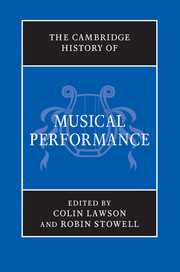Book contents
- Frontmatter
- PART I PERFORMANCE THROUGH HISTORY
- PART II PRE-RENAISSANCE PERFORMANCE
- PART III PERFORMANCE IN THE RENAISSANCE (C. 1430–1600)
- 12 Performance in the Renaissance: an overview
- 13 Vocal performance in the Renaissance
- 14 Instrumental performance in the Renaissance
- 15 Case study: Seville Cathedral's music in performance, 1549–1599
- PART IV PERFORMANCE IN THE SEVENTEENTH CENTURY
- PART V PERFORMANCE IN THE ‘LONG EIGHTEENTH CENTURY’
- PART VI PERFORMANCE IN THE NINETEENTH CENTURY
- PART VII THE TWENTIETH CENTURY AND BEYOND
- PART VIII
- Index
12 - Performance in the Renaissance: an overview
from PART III - PERFORMANCE IN THE RENAISSANCE (C. 1430–1600)
Published online by Cambridge University Press: 28 March 2012
- Frontmatter
- PART I PERFORMANCE THROUGH HISTORY
- PART II PRE-RENAISSANCE PERFORMANCE
- PART III PERFORMANCE IN THE RENAISSANCE (C. 1430–1600)
- 12 Performance in the Renaissance: an overview
- 13 Vocal performance in the Renaissance
- 14 Instrumental performance in the Renaissance
- 15 Case study: Seville Cathedral's music in performance, 1549–1599
- PART IV PERFORMANCE IN THE SEVENTEENTH CENTURY
- PART V PERFORMANCE IN THE ‘LONG EIGHTEENTH CENTURY’
- PART VI PERFORMANCE IN THE NINETEENTH CENTURY
- PART VII THE TWENTIETH CENTURY AND BEYOND
- PART VIII
- Index
Summary
Much more information about musical performance in the period 1430–1600 comes down to us than for any preceding era. We would obviously expect more to survive as we draw nearer to the present, but this alone is not an adequate explanation for the apparent quantum leap in the detail and diversity of the material that survives from the fifteenth and sixteenth centuries. The crucial difference lies in important changes in the nature of what comes down to us and also in the way it was distributed and used. As well as the familiar resources of archives and accounts – which themselves become more abundant and informative than before – we find a far more copious and varied iconography, a greater diversity of literary sources that contain realistic accounts of musical performance, and treatises and books on musical instruction that were aimed at cultivated amateurs as well as the scholarly elite. Most significantly of all, these are preserved not just in the traditional manuscript form, but additionally in the new medium of print, which ensured that all of these sources were both more numerous and more widely distributed than ever before.
If one single social change can be said to have shaped the development of musical performance in the Renaissance and to distinguish it from what went before, it is the increasing involvement of the amateur musician. The city states of Italy fostered the rise of a humanistically educated middle class with artistic aspirations and enough leisure time to pursue them. This in turn encouraged a new context of recreational performance, which, partly through the influence of books like Baldassare Castiglione’s II cortegiano, became an essential accomplishment in genteel society throughout Europe. More music was being performed by more people than had ever been the case previously, and with a different emphasis. The need for a professional to impress and entertain gives way to an aesthetic of elegance in which an amateur could succeed without necessarily being seen to try too hard.
- Type
- Chapter
- Information
- The Cambridge History of Musical Performance , pp. 295 - 317Publisher: Cambridge University PressPrint publication year: 2012

